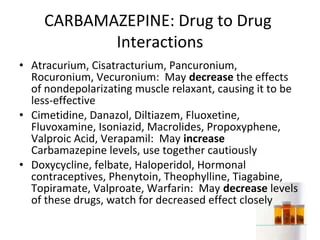A nurse is reviewing the list of current medications for a client who is to start a new prescription for carbamazepine. The nurse should identify which of the following medications interacts with carbamazepine.
Estrogen-progestin combination
Nicotine transdermal system
Diphenhydramine
Beclomethasone
The Correct Answer is A
A. Estrogen-progestin combination:
Correct Answer: This medication interacts with carbamazepine.
Explanation: Carbamazepine is known to induce certain liver enzymes, including cytochrome P450 enzymes. These enzymes play a role in the metabolism of various medications, including estrogen-containing oral contraceptives (estrogen-progestin combinations). Carbamazepine can increase the metabolism of estrogen-progestin combinations, potentially reducing their effectiveness and increasing the risk of contraceptive failure. Therefore, this interaction can lead to decreased contraceptive efficacy and the potential for unintended pregnancy.
B. Nicotine transdermal system:
Incorrect Explanation: This medication does not interact with carbamazepine.
Explanation: Nicotine replacement therapies, such as nicotine transdermal systems, are not known to have significant interactions with carbamazepine. These therapies are primarily used to aid in smoking cessation and do not share metabolic pathways with carbamazepine.
C. Diphenhydramine:
Incorrect Explanation: This medication does not interact with carbamazepine.
Explanation: Diphenhydramine is an antihistamine used for allergies and as a sleep aid. It does not have a well-established interaction with carbamazepine. However, it's important to note that carbamazepine can have central nervous system (CNS) effects, so caution should be exercised when combining it with other medications that also have CNS effects.
D. Beclomethasone:
Incorrect Explanation: This medication does not interact with carbamazepine.
Explanation: Beclomethasone is a corticosteroid used to manage inflammation associated with conditions like asthma and allergic rhinitis. It is not known to interact with carbamazepine. These two medications have different mechanisms of action and do not share significant metabolic pathways.

Nursing Test Bank
Naxlex Comprehensive Predictor Exams
Related Questions
Correct Answer is D
Explanation
A. Decreased vomiting: This might improve as a result of the hypertonic solution treatment, but it is not a specific indicator of improved sodium levels.
B. Cardiac arrhythmias absent: While improvement in serum sodium levels can help prevent cardiac arrhythmias associated with hyponatremia, the absence of arrhythmias does not necessarily indicate that the sodium levels have normalized.
C. Absent Chvostek's sign: Chvostek's sign is associated with hypocalcemia, not hyponatremia. It is not directly related to the effectiveness of hypertonic solution treatment for hyponatremia.
D. Improved cognition
A nurse is caring for a client who has hyponatremia and is receiving an infusion of a prescribed hypertonic solution. The nurse should assess for improved cognition as an indicator that the treatment is effective.
Hyponatremia is a condition characterized by low levels of sodium in the blood. Hypertonic solutions, which have a higher concentration of solutes, are used to raise serum sodium levels. When the sodium levels return to a normal range, the client's cognitive function, including mental clarity and awareness, should improve. Other signs of improvement in hyponatremia include the resolution of symptoms related to fluid and electrolyte imbalance, such as nausea, vomiting, and muscle weakness.
Correct Answer is A
Explanation
A. Hypomagnesemia:
Correct Answer: This electrolyte imbalance is the one the nurse should assess the client for.
Explanation: Lithium is primarily excreted by the kidneys, and its excretion can be influenced by factors that affect renal function, including electrolyte imbalances. Hypomagnesemia (low magnesium levels) can potentially reduce the excretion of lithium, leading to increased lithium levels in the blood. This can increase the risk of lithium toxicity, which can be dangerous. Therefore, monitoring magnesium levels is important in clients taking lithium.
B. Hyponatremia:
Incorrect Explanation: While hyponatremia (low sodium levels) is a potential concern, it is not as directly linked to lithium interaction as hypomagnesemia.
Explanation: Lithium can cause diabetes insipidus, which leads to excessive urination and subsequent loss of water and electrolytes, including sodium. However, hyponatremia is not the immediate electrolyte imbalance that arises due to the interaction with lithium.
C. Hypocalcemia:
Incorrect Explanation: Hypocalcemia (low calcium levels) is not a primary concern in the context of lithium use.
Explanation: Lithium does not have a direct interaction with calcium levels. Hypocalcemia is typically not a result of lithium use or its interaction with other factors.
D. Hypokalemia:
Incorrect Explanation: While electrolyte imbalances like hypokalemia (low potassium levels) can have health implications, it is not the primary electrolyte imbalance to be concerned about with lithium use.
Explanation: Hypokalemia is not a direct consequence of lithium interaction. Monitoring potassium levels is important for overall health, but it's not the primary electrolyte imbalance associated with lithium use and its potential interactions.
Whether you are a student looking to ace your exams or a practicing nurse seeking to enhance your expertise , our nursing education contents will empower you with the confidence and competence to make a difference in the lives of patients and become a respected leader in the healthcare field.
Visit Naxlex, invest in your future and unlock endless possibilities with our unparalleled nursing education contents today
Report Wrong Answer on the Current Question
Do you disagree with the answer? If yes, what is your expected answer? Explain.
Kindly be descriptive with the issue you are facing.
